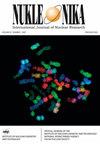利用电离辐射分解城市污水处理厂污水中的双氯芬酸
IF 0.3
4区 物理与天体物理
Q4 CHEMISTRY, INORGANIC & NUCLEAR
引用次数: 0
摘要
摘要研究了双氯芬酸在城市污水处理厂污泥中的分解作用。研究发现,DCF在污泥上的吸附率约为40%。与之前的研究相比,在水溶液中的降解率为100%,在这些剂量高达5 kGy的实验中,只有50%的初始DCF浓度50 mg L−1在沉积物中和沉积物上方的溶液中分解。实验同时使用伽马辐射和电子束进行。已经观察到,沉积物上方的水相中的DCF使用伽马辐射和电子束以相同的效率分解。而对于沉积物中的DCF,当施加伽马辐射时,发现其降解效率更高。这很可能是由于电子束进入淤泥层的穿透深度有限。研究表明,所施加的过氧化物添加(以50 mg L−1 DCF完全矿化所需的化学计量量)不会导致DCF分解产率的增加。本文章由计算机程序翻译,如有差异,请以英文原文为准。
Decomposition of diclofenac in sewage from municipal wastewater treatment plant using ionizing radiation
Abstract The decomposition of diclofenac (DCF) in sewage sludge from municipal wastewater treatment plant was investigated. It was found that adsorption of DCF on sludge is about 40%. Compared to previous studies, where the degradation yield in aqueous solution was 100%, in those experiments at the dose up to 5 kGy, only 50% of initial DCF concentration of 50 mg L−1 was decomposed in sediment and in solution over the sediment. The experiments were carried out using both gamma radiation and electron beam. It has been observed that DCF in the aqueous phase, above the sediment, was decomposed with the same efficiency using both gamma radiation and electron beam. Whereas for DCF in the sediment, a higher degradation efficiency was found when gamma radiation was applied. This is most likely due to the limited penetration depth of the electron beam into the sludge layer. It was shown that the applied peroxide addition (in a stoichiometric amount needed for complete mineralization of 50 mg L−1 DCF) did not cause increase in yield of DCF decomposition.
求助全文
通过发布文献求助,成功后即可免费获取论文全文。
去求助
来源期刊

Nukleonika
物理-无机化学与核化学
CiteScore
2.00
自引率
0.00%
发文量
5
审稿时长
4-8 weeks
期刊介绍:
"Nukleonika" is an international peer-reviewed, scientific journal publishing original top quality papers on fundamental, experimental, applied and theoretical aspects of nuclear sciences.
The fields of research include:
radiochemistry, radiation measurements, application of radionuclides in various branches of science and technology, chemistry of f-block elements, radiation chemistry, radiation physics, activation analysis, nuclear medicine, radiobiology, radiation safety, nuclear industrial electronics, environmental protection, radioactive wastes, nuclear technologies in material and process engineering, radioisotope diagnostic methods of engineering objects, nuclear physics, nuclear reactors and nuclear power, reactor physics, nuclear safety, fuel cycle, reactor calculations, nuclear chemical engineering, nuclear fusion, plasma physics etc.
 求助内容:
求助内容: 应助结果提醒方式:
应助结果提醒方式:


